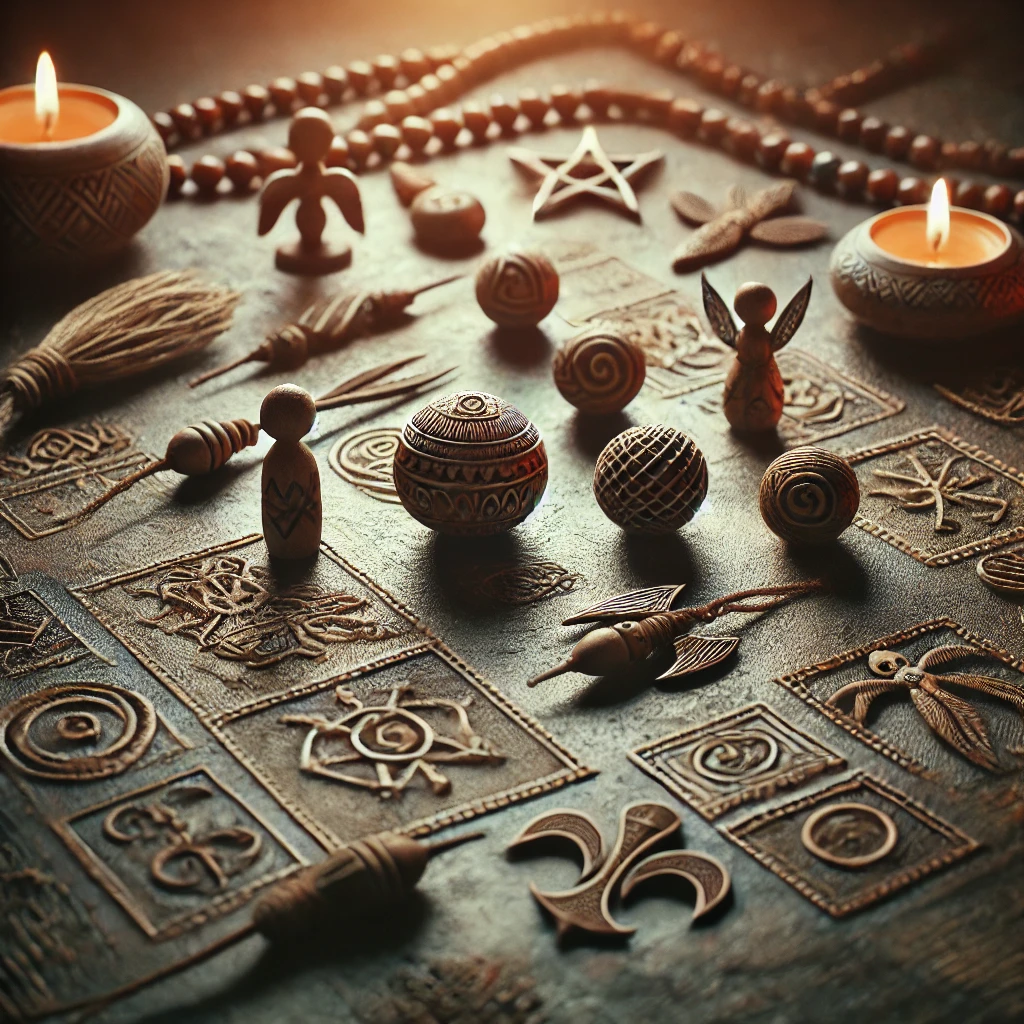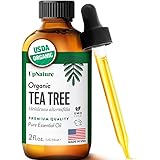In Voodoo, symbols hold great spiritual power. One of the most important and sacred symbols used in Voodoo rituals is the veve. Veves are intricate, stylized drawings that represent specific lwa (spirits) and are used to invoke their presence during ceremonies. Each veve carries profound meaning, acting as a spiritual key that opens a connection between the physical and spiritual worlds.
In this article, we will explore the purpose and significance of veves in Voodoo, examine how they are used in rituals, and decode the meanings behind some of the most common veves associated with the lwa.
UpNature Tea Tree Oil - 100% Pure USDA Certified Organic Tea Tree Essential Oils for Skin, Hair, Toenail, Body and Scalp (2oz)
$9.98 (as of December 24, 2025 14:34 GMT +00:00 - More infoProduct prices and availability are accurate as of the date/time indicated and are subject to change. Any price and availability information displayed on [relevant Amazon Site(s), as applicable] at the time of purchase will apply to the purchase of this product.)What Are Veves in Voodoo?
Veves are sacred geometric drawings that are often created with flour, cornmeal, or other powdery substances on the ground or altar during Voodoo ceremonies. They serve as spiritual beacons that invite the lwa to enter the ritual space and take part in the ceremony. Each veve is unique to a particular lwa, and drawing the correct veve is essential to calling upon the desired spirit.
1. Spiritual Significance of Veves
Veves act as a bridge between the physical and spiritual realms. In Voodoo belief, the lwa do not simply come to a ceremony without being invited; the veve is the symbol that calls them forth. It is believed that the lwa recognize their veve as a personal symbol and that the intricate lines and shapes create a pathway for them to enter the material world.
- Role in Rituals: During Voodoo ceremonies, the veve is drawn on the ground or on the altar, and offerings are placed on or around it. As the ceremony progresses, participants may dance around the veve, further energizing the symbol and strengthening the connection with the lwa.
Fact:
Veves are not just decorative symbols; they are active spiritual tools used to invoke the lwa and establish a connection between the physical and spiritual realms.
The Process of Drawing Veves in Rituals
Drawing a veve is an act of devotion and must be done with precision and care. The process itself is a ritual, often performed by the houngan (priest) or mambo (priestess), although sometimes other participants may be involved. The lines of the veve must be continuous, as any break in the drawing could disrupt the connection with the lwa.
1. Materials Used to Create Veves
Veves are traditionally drawn with powdered materials such as flour, cornmeal, or ashes. These substances are chosen for their ability to create fine, precise lines, which are essential for the intricate designs of the veves. In some cases, colored powders may be used to add additional symbolism to the veve.
- Cornmeal or Flour: These are the most commonly used materials for drawing veves. Their fine texture allows for detailed designs, and their natural, organic origin connects them to the earth and the spirits.
- Colored Powders: Sometimes, veves are drawn using colored powders that carry specific meanings. For example, red might be used for Ogou, the lwa of strength and war, while white might be used for Papa Damballah, the serpent lwa associated with purity and wisdom.
2. The Ritual of Drawing the Veve
The act of drawing the veve is considered a sacred moment in the ceremony. The practitioner must focus their intent, invoking the spirit they wish to call upon as they carefully form each line of the veve. Once the veve is complete, offerings such as food, candles, and drinks are placed around it as a sign of respect and devotion to the lwa.
- Ritual Purpose: The veve is drawn as a way of inviting the lwa to the ceremony. Once the veve is complete, drumming and chanting may begin, further amplifying the spiritual energy and encouraging the lwa to manifest.
Example:
Before a ceremony to ask for protection, a practitioner might draw the veve of Papa Legba, the gatekeeper of the spirit world, asking him to open the way for other lwa to enter and participate in the ritual.
Journeys Out of the Body
$21.83 (as of December 25, 2025 18:12 GMT +00:00 - More infoProduct prices and availability are accurate as of the date/time indicated and are subject to change. Any price and availability information displayed on [relevant Amazon Site(s), as applicable] at the time of purchase will apply to the purchase of this product.)Decoding Common Voodoo Veves and Their Meanings
Each veve has a unique design that reflects the attributes, powers, and personality of the lwa it represents. Understanding these symbols is key to decoding their spiritual meanings and knowing which lwa is being invoked during a ceremony.
1. Veve of Papa Legba: The Gatekeeper
Papa Legba is one of the most important lwa in Voodoo, known as the gatekeeper between the human and spirit worlds. He must be invoked at the beginning of any ceremony to open the way for other lwa to enter. His veve is simple yet powerful, typically consisting of a cross (symbolizing the crossroads) and a cane, reflecting his role as the guide between realms.
- Crossroads: The central cross in Legba’s veve represents the crossroads, a powerful symbol of transitions, decisions, and paths in life. As the gatekeeper, Legba helps guide practitioners in making decisions and choosing the right path.
- Cane: The cane reflects Legba’s role as an elderly figure who provides wisdom and support. It also signifies his ability to walk between the worlds of the living and the dead.
Meaning:
The veve of Papa Legba is a symbol of communication, wisdom, and guidance. It is used to invoke his presence when seeking spiritual direction or when opening the door for other lwa during rituals.
2. Veve of Erzulie Freda: The Spirit of Love and Beauty
Erzulie Freda is the lwa of love, beauty, and luxury. Her veve is often intricate and elegant, reflecting her graceful and feminine nature. It usually includes a heart, symbolizing her association with love and desire, as well as various other elements like flowers or mirrors, which represent her vanity and love of luxury.
- Heart Symbol: The heart is central to Erzulie Freda’s veve, symbolizing romantic love, emotional connection, and desire. She is often invoked during rituals for love, beauty, and personal relationships.
- Flowers and Mirrors: These symbols represent Erzulie’s love for beauty, luxury, and fine things. Mirrors, in particular, reflect her vanity and her desire to be admired.
Meaning:
The veve of Erzulie Freda is used to invoke love, beauty, and emotional healing. It represents the desire for connection, affection, and material blessings.
3. Veve of Ogou: The Warrior Spirit
Ogou is the lwa of war, strength, and iron. His veve is strong and direct, often featuring swords, machetes, or other symbols of power and warfare. Ogou is invoked for protection, strength, and victory in battles—both physical and spiritual.
- Swords or Machetes: These symbols of warfare reflect Ogou’s power as a warrior spirit. They are often drawn in his veve to signify strength, courage, and the ability to overcome obstacles.
- Iron Cross: As the lwa of iron, Ogou’s veve may include an iron cross or other symbols of metal, representing his dominion over tools, weapons, and the force of will.
Meaning:
Ogou’s veve is used to call upon strength, protection, and success in battles or challenges. It represents courage, resilience, and the power to overcome adversity.
4. Veve of Damballah: The Serpent Spirit
Damballah is the serpent lwa, associated with purity, wisdom, and creation. His veve is elegant and flowing, often featuring serpent-like curves that reflect his snake form. Damballah is invoked for spiritual cleansing, healing, and renewal.
- Serpent Symbol: The snake in Damballah’s veve represents renewal, transformation, and the life force. It symbolizes his connection to water and the earth, as well as his ability to bring about healing and purification.
- Curving Lines: The flowing, curving lines in Damballah’s veve reflect his grace and wisdom, as well as his role as a nurturing, father-like figure who brings peace and serenity.
Meaning:
Damballah’s veve is used in rituals for purification, healing, and spiritual renewal. It represents wisdom, tranquility, and the life-giving force of creation.
The Secret Teachings of All Ages: An Encyclopedic Outline of Masonic, Hermetic, Qabbalistic and Rosicrucian Symbolical Philosophy (Dover Occult)
$21.23 (as of December 25, 2025 18:12 GMT +00:00 - More infoProduct prices and availability are accurate as of the date/time indicated and are subject to change. Any price and availability information displayed on [relevant Amazon Site(s), as applicable] at the time of purchase will apply to the purchase of this product.)The Power of Veves in Voodoo Ceremonies
Veves are not just symbols—they are powerful spiritual tools that act as the visual and energetic representation of the lwa. When drawn correctly, veves serve as a call to the spirits, asking them to participate in the ceremony and provide their blessings. Each line and curve carries meaning, and the process of drawing the veve is an act of devotion that helps ensure the success of the ritual.
1. Veves as a Spiritual Language
In Voodoo, veves are seen as a form of spiritual communication. They are a language that speaks directly to the lwa, inviting them into the ritual space and offering them a way to interact with the physical world. Drawing a veve is akin to sending a message to the spirit, letting them know that their presence is needed and appreciated.
- Invocation Through Symbols: Just as prayers and chants are used to call upon the lwa, veves serve as a visual prayer, inviting the spirits to join the ceremony and provide their guidance, protection, or healing.
2. The Role of Offerings in Activating Veves
Once the veve is drawn, offerings are placed around or on top of it to activate its power and show respect to the lwa. These offerings may include food, drink, candles, flowers, or personal items that the lwa favors. The placement of these offerings is crucial, as it shows the lwa that the practitioner is serious about their request and willing to make sacrifices in exchange for the spirit’s help.
Example:
In a healing ceremony for someone who is ill, the practitioner may draw the veve of Damballah, place white candles and offerings of water and fruit around it, and chant prayers to ask for the lwa’s help in restoring health and balance.
READAEER Small Size Human Skull Resin Statue Head Sculptures Skull Collectible Figurines (Black & Golden)
$9.99 (as of December 25, 2025 18:12 GMT +00:00 - More infoProduct prices and availability are accurate as of the date/time indicated and are subject to change. Any price and availability information displayed on [relevant Amazon Site(s), as applicable] at the time of purchase will apply to the purchase of this product.)The Sacred Language of Voodoo Veves
Veves are far more than artistic symbols; they are sacred drawings that serve as a gateway between the physical and spiritual worlds. Each veve is a key that unlocks the power of the lwa, allowing them to enter the ritual space and provide guidance, protection, healing, or blessings. By understanding the meaning behind these sacred symbols, practitioners of Voodoo can communicate with the spirits more effectively and strengthen their connection with the divine.
Related Articles
- Candles, Herbs, and Oils: Tools of Voodoo Rituals and Their Uses
- Voodoo Altars: How to Build a Sacred Space for Worship
- Voodoo Dolls: History, Myths, and True Purpose
- The Power of Gris-Gris: Protection and Blessings in Voodoo
- Decoding Voodoo Symbols: The Meaning Behind Sacred Veves




